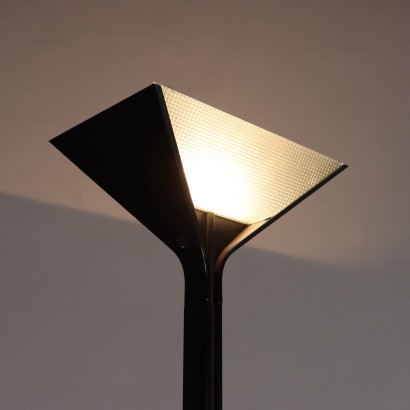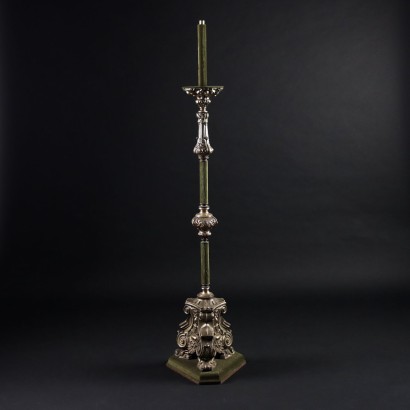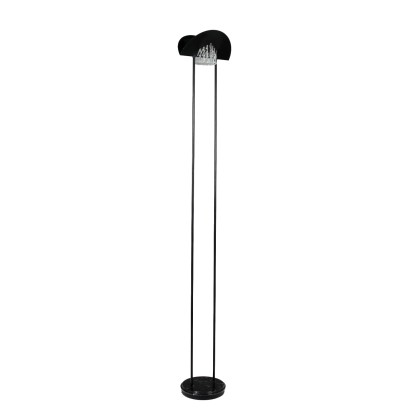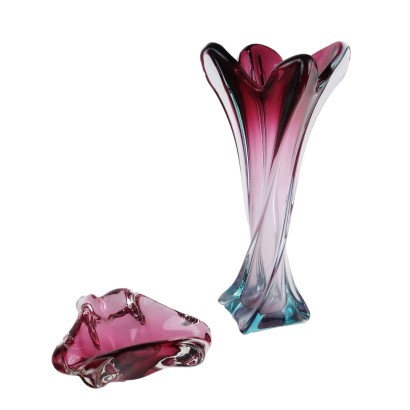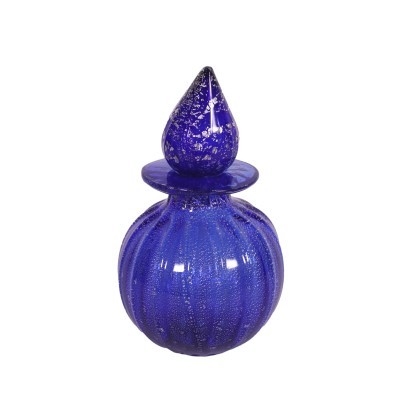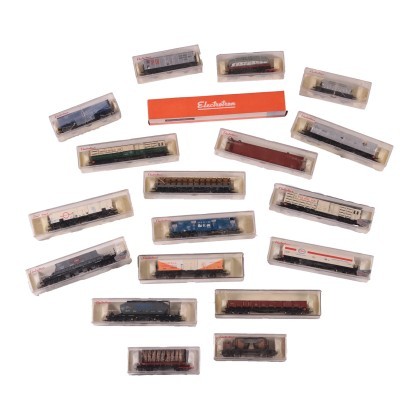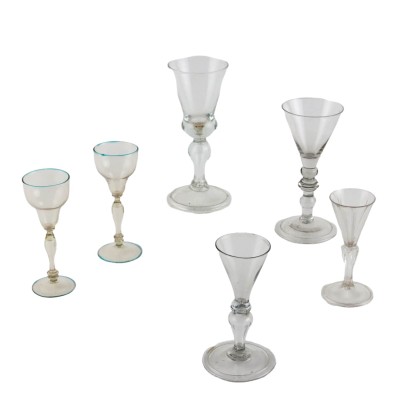Flos Papillona Lamp by T. Scarpa Aluminium Italy 1970s
Features
Designer: Tobia Scarpa
Production: Flos
Model: Papillona
Time: 1970s
Production country: Italy
Material: Lacquered Aluminum , Enamelled aluminum , Glass
Description
Vintage floor lamp with structure in enamelled and black and red lacquered aluminum and prismatic glass diffuser.
Product Condition:
Lamp in good condition, has small signs of wear. We try to present the real state of the lamps as fully as possible with photos. If some details are not clear from the photos, what is reported in the description will prevail.
Dimensions (cm):
Height: 192
Width: 25
Depth: 25
Additional Information
Designer: Tobia Scarpa
Tobia Scarpa carries out the first works at the Venini glassworks. 1957 - starts working with Afra Bianchin. 1959/60 - Tobia Scarpa realizes the first design project in the Furniture course held by Franco Albini (Pigreco armchair). 1959/63 - Collaborates with his father Carlo, teacher of the I.U.A.V. (University Institute of Architecture of Venice) to design architecture projects. 1969 - They graduate in architecture at the Faculty of Venice, but they already have a consolidated professional activity behind them. 1960 - They actively participate in the birth of the Flos company. 1960/63 - They collaborate with Dino Gavina as designers and create the "Bastian" sofa and the "Vanessa" bed. 1963 - The collaboration with the Meda company begins. 1964 - They collaborate with the Stildomus company whose owner is Aldo Bartolomeo. They meet Luciano Benetton for whom they will design the first factory (the knitwear factory), the house, and the chain of stores, protagonist of a new attitude for the management of production, distribution and sales, thus taking care of the company's image. 1966 - They design for Eclisse and Vico Magistretti. 1981 - They design for Goppion. 1986 - Collaborate with Casas. 1987 - Collaborate with Meritalia. 1989 - They design for the IB Office.Find out more about Tobia Scarpa with our insights:
FineArt: Two 'Soriana' armchairs
FineArt: Three seater sofa 'Soriana'
FineArt: Two seater sofa 'Soriana'
FineArt: Two 'Soriana' armchairs < br/> FineArt: Sofa 'Soriana' two seats
Soriana, the sofa with a complex image
Production: Flos
At the origin of Flos there is first of all a luminous idea, the thought that from a light bulb, or rather from a new idea of how to draw artificial light, objects could be born that could change the way of life of the people. Italians: population as we know very spoiled by being born, raised and lived in a territory where at every step they stumble into something that has to do with art. At the end of the 50s a gentleman called Dino Gavina, a very individualistic gentleman and almost possessed by the idea that Italy should be the new home of a new furniture culture, after having met the inventor and small producer from Merano Arturo Eisenkeil took it into his head that after creating many new furniture (with Achille and Pier Giacomo Castiglioni, Ignazio Gardella, Carlo and Tobia Scarpa and other geniuses of Italian architecture), the time had come to create new lamps. The cocoon technique used by Eisenkeil, a resin sprayed on a metal frame, seemed perfect to begin with: it was not a question of decorating a light bulb, but of giving magic to the light that came from it filtering through a hazy but therefore fascinating material, such as are the clouds. Soon the cocoon technique was followed by many others, beautiful and still very surprising for that country still so tied to old ideas of furniture: so that, like it or not, already from its prehistory Flos (i.e. the company with the invented name by Pier Giacomo Castiglioni, who succeeded Eisenkeil) found itself in that interesting, sometimes uncomfortable position of someone who is obliged to continually produce objects of invention. In 1966 a new phase opens with the passage of the company from the artistic management of Dino Gavina to the more entrepreneurial one of Sergio Gandini. Already engaged since 1959 in furnishing with his wife Piera in the Stile store in Brescia (a space that is already a point of reference for many companies in the sector), when Flos moved to his city, to exploit the historical expertise of what Today it would be called an industrial district for metalworking, Gandini was soon involved as a partner in the company by Gavina himself and by Cesare Cassina. Afra and Tobia Scarpa and the Castiglioni brothers, since then and for many years to come, will be the creative soul of the entire Flos production. In the case of Flos, the encounter with the two Castiglioni brothers is certainly fortunate, first, and then with Achille alone, upon Pier Giacomo's premature death in 1968. Inventors more than architects, artists as well as designers, are able to assemble existing industrial components (as in the Toio, or in the Mezzadro stool for Zanotta) or invented (as in the Arco, the Splugen, the Black and White or the Parentesi, designed in 1969. with Pio Manzù) to create new kinds of artificial lighting, with an immediacy of form and meaning difficult to find in other designers. Even more exemplary is the harmony that is created between them and Sergio Gandini, when he calls them to be jointly responsible for all product choices. It is no longer just a question of creating an important object, a formal sign of great mastery, but of designing its entire life cycle in production and on the market, up to its final use. The beautiful utopia of the object that necessarily meets the public's taste only for the skill of the designer is overcome by a concrete realism, which makes Gandini, Castiglioni and Scarpa work together on problems such as packaging, graphics, storage, distribution, with the same commitment dedicated to the study of light or the material of the product. The first foreign company was opened in Germany in 1971, while 1973 was the year of the expansion of the plant (from 800 to 5400 square meters) and of the acquisition of Arteluce: the one-man-company of Gino Sarfatti, one of the most great Italian talents in the lighting design, author since the 40s of excellent pieces but then linked to a dimension of the product and of the supply still to a large extent. With the collaboration of Paolo Rizzatto, then a novice designer, and Marco Pezzolo as director, Gandini began to reprogram the catalog: he kept a few original iconic pieces by Sarfatti, generating over time with designers such as King Miranda and Arnaldi, Ezio Didone, Marc Sadler, Matteo Thun, Rizzatto himself, a series of very successful and commercially important new products. The real strategic change, however, takes place with the arrival of Philippe Starck, who begins the collaboration with Arà (1988), a curious adjustable horn lamp that reflects the fabulous imagery of an author launched towards extreme popularity. Piero Gandini has already sensed the commercial possibilities of Starck's work and gladly accepts when he, now well-known as an interior designer, proposes to mass-produce a small plastic object imagined for a New York hotel: Miss Sissi, a sort of icon of 'abat-jour, "What everybody thinks in their unconscious a lamp is", "What everyone in their unconscious thinks like a lamp" Starck would say in one of his lectures years later. Sergio Gandini initially had some doubts, but in 1991 the project went into production and was an incredible success. With the 90s the slow decline of the incandescent lamp continues, which yields to the invasion of the low energy consumption one, while the LED one begins to take shape as a real revolution.Time: 1970s
1970sMaterial:
Lacquered Aluminum
Enamelled aluminum
Glass
Other customers have searched:
Lampada da terra design, lampada da terra modernariato, lampada da terra anni '70, lampada da terra anni '60, lampada da terra anni '50, lampada da terra design, lampada a stelo..
Se vuoi conoscere qualcosa in più sul mondo dell'illuminazione di modernariato, consulta gli approfondimenti del nostro blog:
Che cos'è il vetro opalino
Il lampadario Maria Teresa, un grande classico dell'illuminazione
Due epoche per un lampadario dal gusto unico
Lampadari Neoclassici Eleganti per Ricevimenti
Le Icone del design:
Lampada Arco: icona tra le icone
Esempi di abbinamento di lampade da terra di modernariato con altri arredi, su Corner MiX:
Corner MiX n.5
Corner MiX n.18
Consulta anche il nostro Catalogo illuminazione FineArt in cui puoi trovare lampade da terra di rara bellezza, come, per esempio:
Lampada LTE8 di Ignazio Gardella per Azucena
Lampada LTE10 Luigi Caccia Dominioni
Lampada "Excalibur" Ettore Fantasia e Gino Poli per Sothis
Lampada da terra 'Prisma LTE12', Ignazio Gardella per Azucena
Lampada da terra 'Polimnia', BBPR per Artemide
Lampada da Terra 'Ro' Studio BBPR
Coppia di Candelabri, Claude Francois Rabiat, Parigi, 1810 ca.
Sul modernariato in generale
From the Sixties to the Sixteenth Century – From the Sixteenth Century to the Sixties
Sedute design
Le sedute e la nascita del design
Sacco - la poltrona trasformista
Valigia - la lampada da viaggio
Pistillino - la natura che incontra il design
Eames lounge chair
Tizio by Artemide - l'equilibrio del movimento
Come dare un look mid century alla propria casa
Design scandinavo vs Design Italiano
Alla scoperta del modernariato
Alternative proposals
It could also interest you



